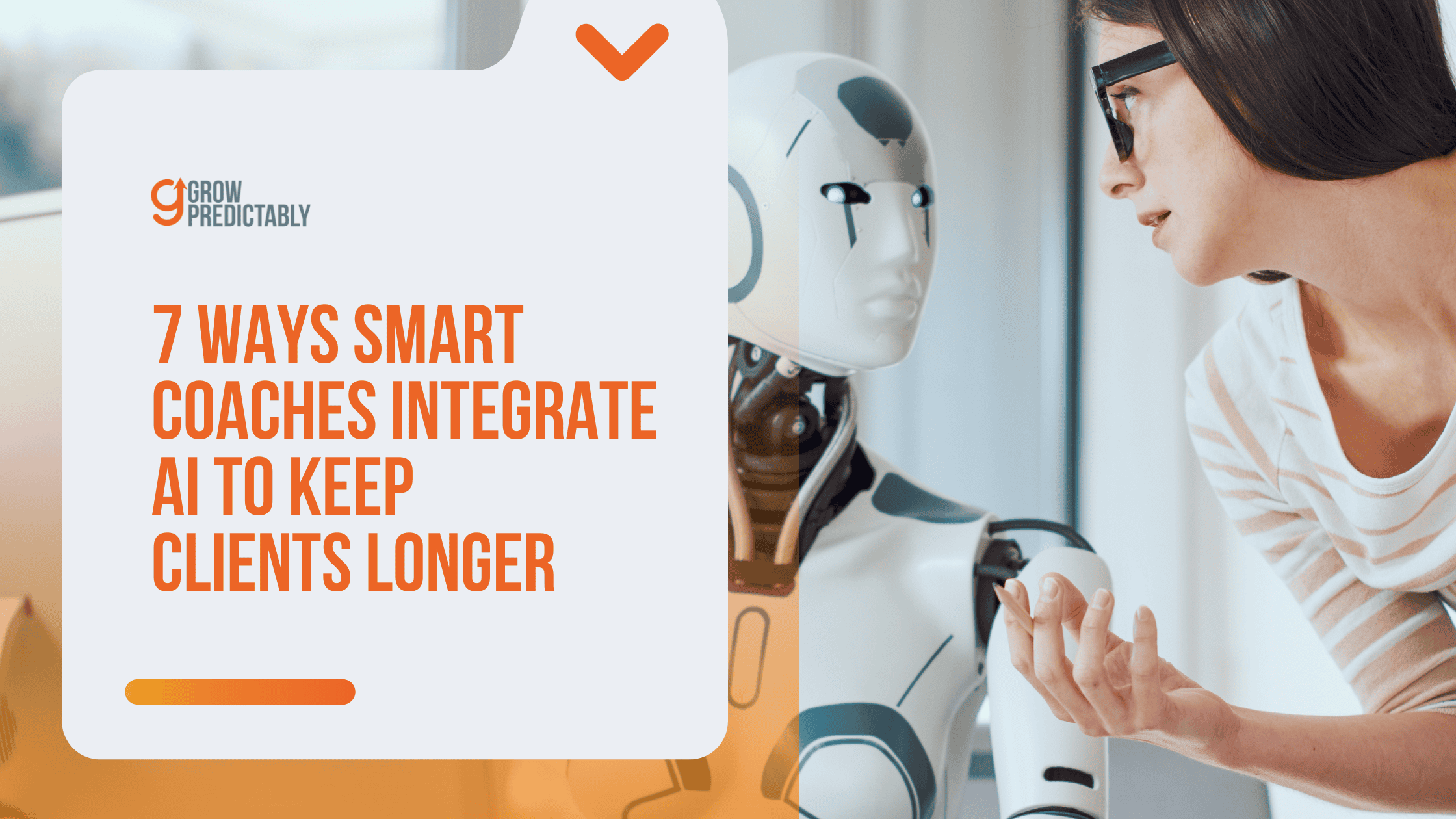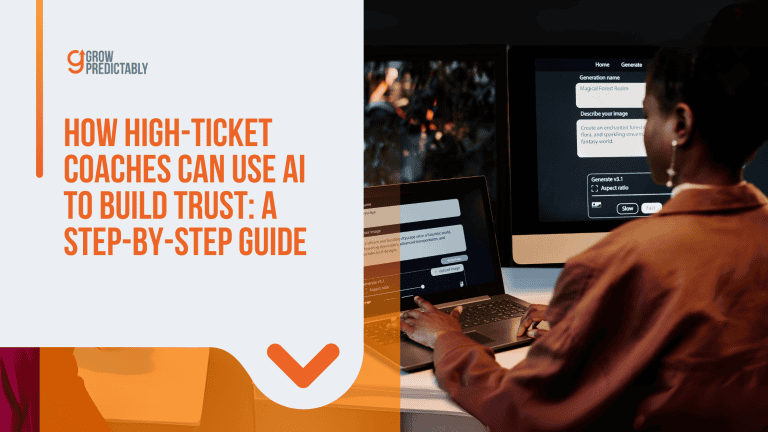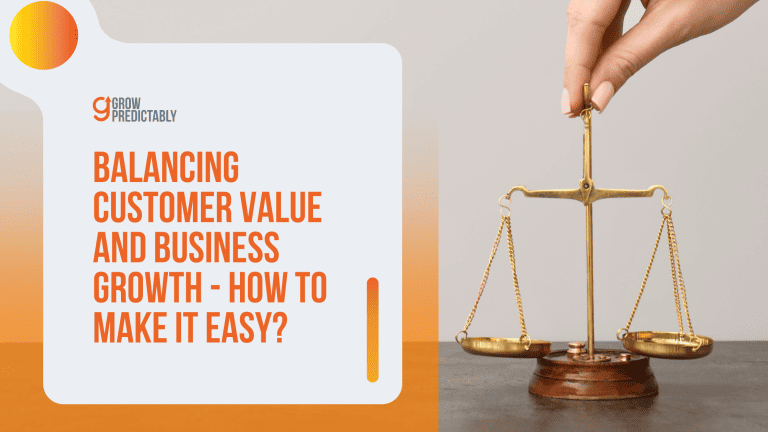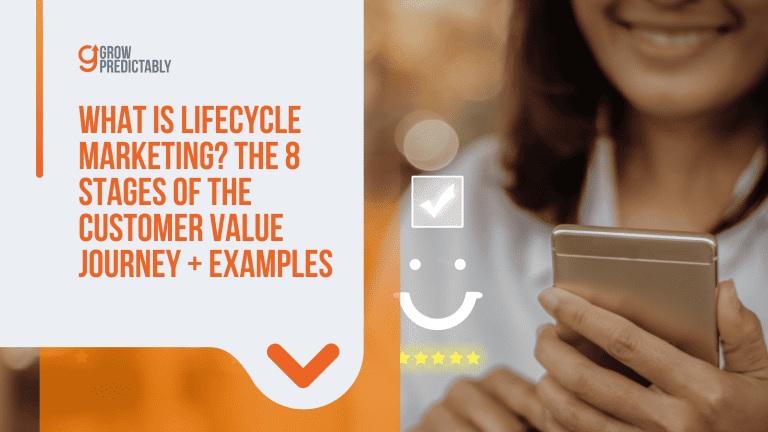7 Ways Smart Coaches Integrate AI to Keep Clients Longer
Let’s face it—coaches everywhere wonder: does AI improve customer retention for coaches?
The answer is a clear yes.
AI-powered retention systems help you spot early warning signs in client behavior—like delayed responses or missed check-ins—so you can proactively intervene and slash client churn by up to 30%.
Imagine having AI automate key follow-ups, personalize session summaries, and celebrate milestones for you, all while preserving your unique coaching voice and freeing up hours each month.
This means more clients stay engaged longer, giving you measurable upticks in retention rates, renewal revenue, and overall impact—without burning out or losing the human connection
Ready to keep more clients without spending more hours?
This is your roadmap to smarter, stronger client retention—powered by AI.
TL;DR
AI can significantly improve client retention in coaching by personalizing experiences, predicting disengagement, and automating nurturing tasks. By leveraging AI tools, coaches can identify subtle behavioral shifts, offer adaptive coaching, and maintain client engagement without sacrificing personalization.
KEY TAKEAWAYS
- Start by mapping your client journey to identify key drop-off points where AI intervention can be most impactful.
- Choose AI tools that match your specific retention challenges, such as automated reminders or engagement tracking.
- Implement and test simple automated workflows that respond to client behavior, gradually adding complexity as you gain comfort with the technology.
What Is AI’s Role in Improving Customer Retention for Coaching?
Imagine this scenario: you have a silent partner spotting client drop-offs before you even see them coming.
Imagine knowing exactly when a high-ticket client starts losing momentum—not after they’ve gone cold, but right when their engagement first dips.
For coaches juggling multiple premium clients, maintaining customer engagement and the challenges are real.
Inconsistent package renewals, emotional exhaustion from constant high-touch service, and that sinking feeling when a client suddenly disappears are all too common.
You’re not alone in this struggle.
Industry-wide, coaches from different niches have to fight churn in one way or another:
- Professional services, including consulting and coaching, have an average churn rate of 27%.
(Source) - Online coaching businesses can experience churn rates as high as 19.2%, though targeted efforts can reduce this to 5%.
(Source) - The average annual churn rate for subscription companies (including coaching platforms) is 5–7%.
(Source)
Consequently, if coaches want to rise above this challenge, they will need modern solutions — like AI.
AI customer retention isn’t just another tech buzzword.
It’s becoming a game-changer for coaches who want to protect both their client relationships and their own energy.
In a brief overview, coaches can expect the following advantages of leveraging AI in coaching:
Sure, here you go:
- Enhanced Client Retention: AI predicts disengagement, allowing timely actions to keep clients engaged.
- Personalization: Tailors coaching sessions by analyzing client data, improving satisfaction and results.
- Efficiency: Automates repetitive tasks, letting you focus more on impactful coaching activities.
- Scalability: Supports more clients without sacrificing personalized attention.
- Data-Driven Insights: Provides valuable behavior analytics to refine coaching strategies.
- Consistent Follow-Ups: Ensures no client falls through the cracks with automated reminders and check-ins.
AI really boosts both the effectiveness and efficiency of coaching businesses.
But how exactly does AI driven retention tactics enhance the customer experience in the coaching world?
What is Predictive Analytics for Coaches?
Think of predictive analytics as your coaching sixth sense.
Just like you can sense when a client has an “aha moment” during a session, AI can detect subtle shifts in customer behavior that might signal disengagement:
- Delayed responses to your messages
- Dropped accountability check-ins
- Changes in session scheduling patterns
- Shifts in engagement with homework materials
Instead of discovering problems after clients ghost you, predictive tools use customer data to give you early warning signals.
You can step in at just the right moment with the perfect intervention.
How Does NLP and Machine Learning Impact Retention?
Natural Language Processing (NLP) is like having an emotional intelligence assistant that never gets tired.
It can analyze:
- Session transcripts for changes in client language and tone
- Message exchanges for enthusiasm levels
- Follow-up responses for signs of hesitation
Meanwhile, machine learning studies patterns across your entire client base.
For example, it might notice that changes in customer behavior like rescheduling twice in the first month have a 70% higher drop-off rate.
This gives you a chance to address the pattern before it becomes a problem.
One executive coach I know discovered that week 4 was her “danger zone” in the customer experience.
This was the exact point where excitement from initial breakthroughs started wearing off.
Now her AI system automatically sends extra check-ins and inspiration during this critical period.
Can AI Support Scaling a Coaching Business?
Let me be clear: AI doesn’t replace the human connection that makes coaching powerful.
Instead, it handles the logistics so you can focus on transformation.
For instance:
- Automated session reminders with personalized notes
- Follow-up emails with key insights from your sessions
- Progress tracking that celebrates client wins
- Early warning systems for engagement dips
The result?
You’re free to pour your energy into what matters most—deep coaching work—while knowing no client is falling through the cracks.
This only helps ensure customer satisfaction for the long term.
Salesforce reports that 91% of SMBs using AI say it’s boosted their revenue. (Source) And round 78% of surveyed companies worldwide use AI in their operations in at least on business function. (Source)
Can AI Improve The Customer Journey?
The magic happens when AI provides personalized support and enhances each stage of your customer experience journey.
For example:
- In the Excite stage, AI helps maintain momentum after the initial sale with perfectly timed check-ins
- During Convert, it identifies which prospects need extra nurturing
- Throughout Ascend, it highlights opportunities for deeper client work
- In Advocate, it recognizes when clients are ready to share their success stories
This structured approach ensures every client receives the right message at the perfect moment.
It’s not just about improving retention, enhancing customer satisfaction, and encouraging customer engagement but building true advocates for your coaching practice.
The bottom line?
AI customer retention empowers you to protect what matters most—your impact and energy—while making sure clients stay engaged at each stage of their journey with you.
Let’s dive into the specific AI technologies transforming coaching retention next…
How Does AI Improve Client Retention for Coaching Services?
What if you could predict a client’s disengagement before they stop showing up?
Imagine, then, having an AI powered silent partner that spots subtle shifts in client behavior, giving you time to intervene before they’re gone.
For high-ticket coaches, client retention isn’t just about revenue—it’s about impact, reputation, and building a sustainable business without burning out.
While you’re focused on delivering transformational sessions, AI works behind the scenes, handling the signals you might miss when juggling multiple premium clients.

1. Personalized Client Experiences
Have you noticed how your best clients stay longest when they feel truly seen and understood?
In this regard, AI helps analyze customer data, session feedback, journaling entries, and behavior patterns to help you tailor coaching goals with remarkable precision.
A report from the IBM Institute for Business Value reveals that three in five consumers prefer to use AI applications in their shopping experience.
Moreover, according to McKinsey, 71% of consumers expect companies to deliver personalized content. (Source)
Let’s take Emma, a life coach working with C-suite executives.
One of her $20,000 leadership clients was showing subtle signs of misalignment in their goals.
By using AI to analyze their session transcripts and homework submissions, Emma spotted a pattern: her client’s language had shifted from career advancement to work-life integration.
She adjusted their coaching focus mid-program, resulting in the client not only completing their package but upgrading to a year-long retainer.
This personalization happened right at the crucial ‘Engagement’ and ‘Excite’ stages of the Customer Value Journey, when clients are deciding if the investment is truly worth it.
How might your own clients’ needs be evolving beneath the surface of your conversations?
2. Predictive Analytics for Churn Reduction and Strengthening Customer Relationships
Client drop-off rarely happens without warning.
According to Forrester research, AI-powered retention strategies can, therefore, reduce churn by up to 30% by identifying risk signals before they become problems.
For coaches, these signals might include:
- Delayed responses to your messages
- Declining engagement with homework materials
- Shorter session durations
- Subtle shifts in language or tone during calls
When these patterns emerge, AI triggers retention-risk alerts, giving you time to reach out personally and address concerns before your client mentally checks out.
What 3 behaviors signal disengagement in your coaching funnel?
How quickly do you currently spot them?
3. Real-Time Feedback and Adaptive Coaching
The days of rigid coaching programs are fading, as AI tools continue to improve customer satisfaction with more flexible solutions.
Today’s premium clients expect personalized journeys that adapt to their changing needs and progress.
Tools like Practice.do analyze customer feedback and session outcomes to help you adjust scheduling and content dynamically.
When a client reports breakthrough progress, the system might suggest spacing sessions differently or introducing new challenges to maintain momentum.
This adaptive approach keeps clients in the ‘Excite’ stage longer—ensuring they continue experiencing emotional payoffs as customer behavior is influenced positively even after the initial conversion excitement fades.
One business coach shared: “My high-ticket clients used to hit a plateau around month three. Now my AI-assisted program adjusts automatically based on their reported wins and challenges. Renewal rates jumped from 40% to 75% in six months.”
4. Automated Follow-Up and Nurturing of Existing Customers
How many potential client renewals fall through simply because follow-up gets lost in your busy schedule, affecting customer loyalty?
Platforms like CoachAccountable or Intercom message flows can automatically reengage clients after periods of silence, sending personalized check-ins that feel thoughtful rather than robotic.
One leadership coach recovered 2 high-ticket clients in 48 hours using automated nudges when they hadn’t scheduled their next sessions.
The messages appeared to come directly from her but were triggered by the system when it detected a 10-day gap in engagement—something she might have missed while focused on delivering sessions to active clients.
These systems work while you sleep, ensuring no client falls through the cracks during your busiest periods.
Clearly, AI has revolutionized how companies handle lead nurturing, achieving outcomes that traditional methods could never match. (Source)
The role AI plays in lead nurturing is evident:
- Predictive lead scoring improves qualification accuracy by 40%
- Personalizing outreach leads to 38% higher sales win rates
- Automation powered by AI reduces manual tasks by up to 60%
5. Scalability Without Sacrificing Personalization
The biggest fear for many coaches is that automation will make their practice feel cold or impersonal.
In reality, AI handles scalable logistics, not human nuance.
For instance, sending personalized session reflections via AI powered systems allows you improve customer engagement and stay front-of-mind without spending hours writing individual emails.
One executive coach uses AI to generate custom session summaries highlighting key breakthroughs and next steps.
Clients receive these within an hour of their call, reinforcing the value they received and building anticipation for the next session.
This kind of touchpoint is crucial in the ‘Advocate’ and ‘Promote’ stages, leveraging customer feedback when clients are deciding whether to become vocal supporters of your coaching practice.
The promise of AI isn’t about replacing your coaching magic—it’s about working smarter, not harder.
By reducing churn, increasing customer lifetime value, and preserving your bandwidth for deep client work, AI helps you grow your practice sustainably.
How exactly does this work in real coaching businesses?
We’ll explore real-world examples shortly, where coaches just like you have transformed their retention rates with these powerful tools.
Step-by-Step Guide to Integrating AI into Your Coaching Retention Strategy
If you’ve ever felt like clients fade after week 3, you may be missing key behavioral markers—here’s how AI helps.
Building a retention system doesn’t have to be overwhelming!
Let’s break this down into manageable steps that match your comfort level with technology.
1. Evaluate Your Current Client Journey (Easy)
Map out where clients typically drop off in your program.
Is it right after the initial excitement wears off?
Or when they hit a challenging milestone?
Take a piece of paper or use a simple tool like Miro to visualize your client’s path.
Mark the spots where engagement dips—these are your gold mines for AI intervention!
Connect these points to Customer Value Journey stages to see patterns more clearly.
“When I mapped my client journey, I was shocked to see 40% of drop-offs happened in week 4—right when the work gets deeper. That’s where I needed to focus first!”
2. Collect and Organize Client/Customer Data (Moderate)
You already have treasure troves of information that can help you spot warning signs:
- Export chat logs from your messaging platform
- Review session attendance patterns
- Note which homework gets completed (and which doesn’t)
- Track response times to your messages
Look for signals like delayed responses, shortened messages, or skipped check-ins.
These tiny behaviors often predict bigger disengagement before it happens!
3. Choose AI Tools That Fit Your Needs (Easy → Moderate)
Don’t try to overhaul everything at once!
Pick one priority area based on your customer journey map:
- For spotty attendance: Try Practice.do’s automated session reminders
- For homework completion: Consider CoachAccountable’s progress tracking
- For engagement between sessions: Look at simple chatbots through ManyChat
Remember: The right tool matches your biggest retention leak—not necessarily the shiniest new AI on the block!
4. Set Up Automated Workflows (Moderate)
Build simple “if this, then that” sequences that respond to client behavior:
- If a client misses a session → Send a voice memo checking in
- If homework isn’t completed 2 days before the next call → Send an encouraging text
- If a client hits a milestone → Trigger a celebration email with their progress highlighted
Start with just ONE workflow.
Get it working smoothly before adding more complexity.
5. Monitor and Analyze AI Insights (Moderate)
Set aside 30 minutes weekly to review what your tools are telling you:
- Which clients are showing early warning signs?
- What patterns connect your most successful clients?
- Are there common phrases or topics that signal growing commitment?
These insights might surprise you: “Clients who skip one session are 40% more likely to churn unless I reach out within 24 hours.”
6. Adjust Coaching Based on AI Feedback (Advanced)
Use what you learn to refine your approach:
- Restructure program pacing if you see consistent struggle points
- Create additional resources for common sticking points
- Develop new check-in questions based on sentiment analysis
This is where AI becomes your strategic partner, helping you continuously improve your coaching experience.
7. Maintain the Human Connection (All Levels)
The most important step!
AI handles the logistics so you can focus on deepening relationships:
- Send personal voice memos (not just automated texts)
- Schedule surprise 1:1 check-ins when AI flags potential issues
- Create personalized milestone celebrations that reflect your unique coaching style
Remember, clients hire YOU, not your tech stack.
AI is your backstage crew, making sure you show up at your best.
Your customer retention strategies should focus on leveraging AI to enhance the personal touch they receive.
Important questions to ponder on:
- Have you identified your first drop-off point?
- Did you test one low-lift automation this week?
- Which client behaviors will you start tracking?
AI strategy isn’t about massive overhauls—it’s about small, smart steps matched to high-impact insights.
Start with one area where clients typically disengage, apply one simple tool, and watch what happens to your retention numbers as part of your customer retention strategies.
What tiny signal might you be missing right now that could save your next client relationship?
What Tools Can Coaches Use to Boost Retention?
What if the right tool at the right moment could keep your high-ticket clients engaged for months longer?
Let’s explore the AI tools that can transform your coaching business—not by replacing your expertise, but by amplifying your impact across every stage of the customer journey.
| Stage & Method | Tool | Description |
|---|---|---|
| Awareness Stage: Content Generation Tools | Jasper AI (Easy): Creates consistent, value-driven content that keeps you visible to potential clients. | Coaches using AI content tools see up to 26% more visibility year over year. This lets them stay top-of-mind without burning out from content creation. |
| Copy.ai (Easy): Helps draft social posts and emails that sound like you wrote them. | ||
| Engagement Stage: Conversation Enhancement Tools | Manychat (Easy): Builds simple but effective Facebook Messenger bots that answer common questions while you sleep. | AI powered tools keep potential clients engaged during that critical “thinking about it” phase, fostering customer loyalty. This is when most coaching relationships fizzle before they begin. |
| Intercom (Moderate): Uses natural language processing to handle complex pre-coaching conversations and qualify leads. | ||
| Subscribe Stage: Lead Optimization Tools | Unbounce Smart Builder (Moderate): Uses AI to optimize landing pages for maximum opt-ins. | One health coach I worked with increased her email list conversion by 31% just by letting AI suggest better opt-in page layouts and timing. |
| ConvertKit (Easy): Segments subscribers based on behavior patterns to deliver the right message at the right time. | ||
| Convert Stage: Scheduling and Onboarding Tools | Calendly AI Assistant (Easy): Reduces missed appointments through smart scheduling reminders. | The friction in booking that first call often determines whether a prospect becomes a client. These tools smooth that critical transition. |
| Typeform (Easy): Creates intelligent intake forms that adapt based on client responses. | ||
| Excite Stage: Session Enhancement Tools | Practice.do (Moderate): Automatically sends prep work before sessions and summary recaps afterward. | These tools extend the “aha moment” beyond your session time. They keep clients excited about their progress between calls. |
| Fireflies.ai (Easy): Transcribes coaching calls and highlights key moments for client reference. | ||
| Ascend Stage: Upsell and Progress Tracking | Kajabi’s Smart Recommendations (Moderate): Suggests next offers based on client engagement patterns. | A business coach using AI-powered recommendation systems saw her package renewal rate jump from 22% to 47%. This was achieved by timing upsell offers to coincide with client wins. |
| CoachAccountable (Moderate): Tracks client progress and suggests when they’re ready for more advanced programs. | ||
| Advocate Stage: Testimonial and Feedback Collection | CoachAccountable Forms (Easy): Prompts testimonials based on personalized milestones. | These tools capture client wins in their moment of highest excitement. This is when they’re most likely to share powerful testimonials. |
| VideoAsk (Easy): Collects video testimonials automatically when clients hit major goals. | ||
| Promote Stage: Referral Automation | ReferralCandy (Moderate): Automates incentive sharing for client referrals. | |
| Friendbuy (Moderate): Creates customized referral campaigns based on client segments. |
This format ensures readers can easily see the connections between different stages, tools, and additional descriptions, enhancing comprehension and retention.
Implementing effective retention strategies, one life coach doubled her referrals.
She achieved this by using AI to identify which clients were most likely to refer, fostering customer loyalty, and what incentives would motivate them.
GETTING STARTED CHECKLIST
Remember, you don’t need every tool on this list.
What you need is the right tool at the right touchpoint in your client’s journey.
Where are your clients getting stuck or dropping off? That’s where to focus first.
In the next section, I’ll walk you through exactly how to integrate these tools step-by-step, even if you’re not tech-savvy.
But for now, ask yourself: which stage of your client journey needs the most support right now?
Common Concerns and Misconceptions About AI in Coaching Retention
I get it. When someone mentions AI for your coaching business, you might think, “Great, another tech thing that’ll make my work feel robotic.”
Those worries are completely normal!
Let’s talk through what’s really keeping coaches up at night about AI driven strategies—and why those fears might not be as scary as they seem.
“Will AI erase my unique coaching voice?”
This is probably the biggest worry I hear.
Your voice and approach are what make clients choose you over anyone else.
Here’s the truth: AI isn’t replacing your voice—it’s amplifying it.
Think of AI as your assistant handling reminders and follow-ups so you can focus on those breakthrough moments where your unique expertise shines.
As Michael Bungay Stanier puts it: “Coaching is saying the right thing at the right time—AI supports the ‘when.'”
The magic happens when you combine your wisdom with AI’s ability to deliver it at perfect moments.
What if instead of diluting your voice, AI helped it reach more people at exactly the right times?
“Is AI another thing I have to learn?”
I hear you! The last thing you need is another tech tool with a steep learning curve.
Good news: Many AI tools are built specifically for coaches who don’t have time to become tech experts. Platforms like Kajabi and Practice.do offer plug-and-play experiences with strong onboarding support. You don’t need to understand how the AI works—just what you want it to accomplish.
Start small. Pick one pain point (like clients forgetting homework) and let one tool handle that first. You’ll be surprised how quickly you see results without overwhelming yourself.
“Won’t automation feel cold to my clients?”
This worry makes so much sense! After all, coaching is deeply personal work.
The key is thoughtful personalization.
When you set up automated touchpoints, they should feel like extensions of you—not generic messages.
Record voice notes instead of text. Create rules that trigger mini-celebrations when a client hits a milestone.
One coach I know sends automated check-ins between sessions but makes them feel personal by including specific references to what existing customers shared last time.
Her clients often say they feel more supported than ever.
Remember: Automation doesn’t mean removing your presence—it means extending it consistently.
“Can I trust AI analytics to understand my clients?”
Your intuition about clients has been built through years of experience. No AI can fully replace that.
Think of AI analytics as a partner to your intuition, not a replacement.
It might spot patterns across clients that even you miss (like which week most people start to disengage), but you’ll always bring the human understanding of why.
When AI flags that a client’s engagement is dropping, you still decide how to respond based on what you know about them personally.
Action Plan: How Do You Embrace AI to Elevate Your Coaching Retention?
Wow!
What a journey we’ve been on together, exploring how AI can transform your coaching practice, improve customer satisfaction, and turn a constant struggle to keep clients engaged into a smooth system that predicts and prevents drop-offs before they happen.
Let’s take a breath and look at what we’ve uncovered.
AI isn’t just another tech tool—it’s your behind-the-scenes partner that helps you scale your impact, protect your energy, and keep clients progressing through their transformation journey.
AI’s Unique Support in Each Stage of the Customer Value Journey
Throughout each stage of the Customer Value Journey, AI offers unique support for enhancing customer relationships:
- Predict disengagement early (Convert stage) – Catch those subtle shifts in customer behavior before they ghost you completely to boost customer satisfaction
- Automate thoughtful follow-ups (Ascend) – Keep the momentum going with perfectly-timed check-ins that feel personal
- Highlight client wins quickly (Excite) – Celebrate progress in real-time to maintain motivation
- Personalize at scale (Advocate/Promote) – Turn happy clients into raving fans without burning yourself out
The beauty here?
You don’t lose your coaching magic—you amplify it.
AI handles the logistics so you can focus on what you do best: creating those breakthrough moments that change lives.
Your Next Steps
Ready to dip your toes in?
Here’s your simple action plan:
- ✅ Pick one pain point: Where do clients typically disengage? Select one AI tool that addresses this specific drop-off point
- ✅ Connect with peers: Join an AI for coaches community or attend a webinar to learn from others already seeing AI powered results
- ✅ Track your baseline: Before implementing any tool, note your current retention rate so you can measure your wins
Remember that leadership coach who recovered two high-ticket clients in just 48 hours using automated nudges?
Or Sarah who boosted retention by 22% by catching “ghosting precursors”?
That could be your success story next.
I’m excited for you to experience what happens when you’re no longer scrambling to keep clients engaged, but instead have systems that alert you to exactly who needs attention and when.
What if AI helped you stay 10 steps ahead—so your clients always feel one step closer to their goals?
That’s not just good for business—it’s how you create lasting transformation while building a sustainable coaching practice you love.
The future of coaching isn’t just about your brilliance in session—it’s about creating an ecosystem of support that works even when you’re not.
FAQs
Small Steps, Big Wins
To wrap up, this journey through AI-powered retention underscores one simple idea: Small, strategic automations can lead to massive gains in your coaching practice.
From case studies to step-by-step blueprints, the evidence is clear—AI helps you intervene early, celebrate wins, and move clients forward at every stage without spreading yourself thin.
Make the choice to act: map your client journey, identify a key drop-off, and implement your first automation.
Share your experiments in coaching communities or drop your experience in the comments below—let’s build this future together!
Explore supplemental guides, free trials, and support groups to ease your transition.
Tools like CoachAccountable or resources from the “AI in Coaching” newsletter will deepen your confidence.
Which retention metric would you most like to improve—and how could a targeted AI solution accelerate your progress?
How might your coaching style evolve with more bandwidth for deep work?
Embracing AI isn’t about losing your essence. It’s about multiplying your results, energy, and legacy, one smart system at a time.
How can AI be used in coaching?
AI is revolutionizing the coaching landscape by enhancing coach-client interactions and increasing retention rates. Here are several ways AI can be integrated into coaching practices:
- Predictive Analytics: AI can analyze client behavior and predict disengagement, allowing coaches to intervene at the right moment. This helps to maintain client interest and prolong their engagement.
- Natural Language Processing: NLP tools analyze session transcripts to detect changes in client language and tone, flagging potential engagement issues early.
- Automated Follow-Ups: AI systems can autonomously send personalized reminders and follow-ups, ensuring no client is left unattended even during busy periods.
- Personalized Client Experiences: By assessing customer data, AI tailors coaching sessions to meet individual client needs, enhancing satisfaction and long-term retention.
- Real-Time Feedback: AI tools provide coaches with instant insights into client progress, suggesting necessary adjustments in coaching strategies in real-time.
- Scalable Solutions: AI automates routine tasks, freeing coaches from logistical burdens. This allows them to focus more on transformative coaching work.
- Behavioral Insights: AI identifies patterns in client behavior that could indicate potential churn, enabling preemptive measures to retain them.
How much does a mindset coach charge?
Mindset coaching fees can vary significantly based on experience, location, and services offered. On average, mindset coaches charge between $100 and $300 per hour. Some coaches offer packages ranging from a few hundred to several thousand dollars, depending on the length and depth of the program. Coaches operating in high-demand areas or with high-profile clientele might charge premium prices, reflecting their unique expertise and successful track records.
How to use ChatGPT as a health coach?
ChatGPT can be a powerful tool for health coaches looking to enhance client engagement and personalize advice. Here’s how you can integrate ChatGPT into your health coaching practice:
- Personalized Nutrition Advice: Use ChatGPT to provide tailored nutrition tips and meal suggestions based on individual client preferences and dietary requirements.
- Motivational Support: Generate personalized motivational messages to encourage clients during challenging phases of their health journey.
- Track Progress: Automate periodic check-ins via ChatGPT to keep clients accountable and track their progress over time.
- Educational Content: Design interactive learning modules with ChatGPT to educate clients on various aspects of health and wellness, making them more informed and engaged.
- 24/7 Support: ChatGPT can serve as an always-on resource, answering common questions and providing support outside conventional coaching hours, making clients feel supported at all times.
By using these strategies, you can leverage ChatGPT not just as a tool, but as an integral part of your client engagement strategy. This approach ensures clients stay informed, motivated, and connected to their health goals.








